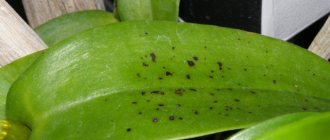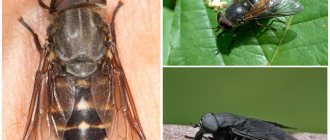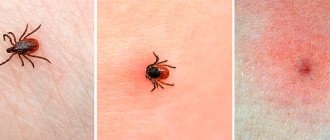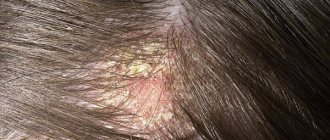In the warm season, not only people enjoy the gentle sun, soft grass and trips outside the city. Pets can also relax and frolic. But being outdoors for your beloved pets can be overshadowed by the fact that in the heat, dogs’ ears and noses are attacked by small midges. And if a person can protect himself from insects with the help of various drugs, then an animal, when flies bite it, needs to be helped and protected.
Predatory flies
Burner flies are one of the most common species of Diptera, closely associated with human habitation.
Most often, their clusters can be seen in a barn, poultry house, next to grazing cattle. They differ from the common fly in their food preferences. The main source of their vital energy is the blood of animals. Due to the proximity of yard dogs to the place where livestock is kept, they suffer no less from these unpleasant insects.
On a note!
Flies bite the most vulnerable places on the animal's body until they bleed - the nose, muzzle, ears. Most often, flies bite dogs' ears, since the hair in this area is very short and there is access to open areas of skin.
Diptera predators eat away at the skin, leaving behind open wounds. The dog cannot drive them away in time and is subjected to frequent bites. To save a faithful friend, owners must know how to treat their dog's ears against flies.
Causes of insect attacks
Houseflies, which accompany us throughout the spring and most of the summer, the most they can do to their “victim” is tickle them with their soft proboscis. It is not able to pierce tough skin. Such insects feed mainly on plant foods and waste products. Generally speaking, they do not pose a danger as such, and even more so they will not be able to bite a pet’s ear until it bleeds.
But when August arrives, a cool wind blows, and burner flies enter the fray. They are just very dangerous for animals. The basis of the diet of such insects is blood, so they live in pastures and farms. That's why they hunt animals: because pets cannot resist them. If flies eat a dog's ears or bite other animals, the owner tries in every possible way to help his pet, since the consequences can be unpredictable. Sadly, both male and female firebirds are bloodsuckers.
It must be remembered that zhigalkas can breed up to 4 times per season. Females lay their eggs, as expected, in compost and manure heaps. The heat from decay promotes the rapid development of larvae. After 5 days, the eggs hatch into young animals, which after (maximum) 8 weeks are able to breed new offspring. So it turns out that the dog is eaten by flies, of which by that time there are a lot. Therefore, you need to arm yourself with knowledge: what to do so that the animal does not suffer from these insects. When it starts to get colder, the zhigalki look for new habitats for wintering. That's why they become neighbors of people in a warm house.
It should be noted that the zhigalka is not picky about its habitat. It is found throughout the world, with the exception of the Far North. After all, at a temperature of -8ºС the insect dies. At the end of summer, insect predators expand their sphere of “influence” and fly into the house. Therefore, if your dog is eaten by flies, you need to immediately find out what to do to get rid of the scourge. After all, people who are unable to ward off biting insects also suffer from stink bugs.
The danger of firebug bites
Zhigalkas are predators, so their mouth proboscis is capable of biting through the ear of a pet, after which a whole flock will begin to feed on this animal. In a very short period of time, insects bite through the skin until it bleeds, and now the owner is faced with the question: what to do to save the pet.
When flies eat a dog until it bleeds, the insect first rubs the victim’s skin with its proboscis, thereby scraping off the epidermis. Well, then it’s a matter of technology. Dinner is served and the dog is eaten by flies until serious wounds appear. Of course, the owner can notice the process much earlier and take serious measures. During a bite, a poisonous secretion is injected into the animal's blood, leading to skin irritation. The poisonous secretion helps prevent the blood from clotting, which means the zhigalka has something to eat. In some cases, when flies eat a dog’s ears, you need to know how to treat it, because an allergic reaction may occur. Together, this can lead to high fever and nausea. This is why the process of “eating” is so painful for the animal.
In addition, zhigalkas carry infectious diseases, among which the most dangerous are:
- anthrax;
- staphylococcal infection;
- sepsis;
- tularemia.
Some of these diseases are zoonotic. This means that they are equally dangerous for both animals and humans. Why do flies and other biting insects become more active in the fall? What to do to prevent infection?
There is an opinion that insects begin their aggressive activity because they sense their death. This statement is fundamentally false. They bite the ear and other parts of the animal's body until it bleeds in order to obtain a daily diet that promotes procreation.
Rat poison acts gradually
The poison is not designed to act immediately, so the rats and mice for whom it is intended die not where they ate it, but in other places. Rodent poison strikes within one to two days.
In dogs, symptoms may begin to appear within a few days or even later. Since dogs are covered with fur, the initial manifestations of poisoning are often completely invisible, and they consist in the fact that hemorrhages begin to appear on the skin of the animals. Internal bleeding may also occur.
How can you tell if your dog needs help?
You can notice that a dog is suffering from flies by characteristic signs that an attentive owner will not miss. Most often, flies bite a dog's ears. The main signs that insects are causing dangerous damage to your pet are as follows:
- flies constantly surround the dog;
- crusts and blood are always present at the tips of the ears;
- inflamed wounds at the bite sites;
- hair loss in the area of the lesions;
- the appearance of eggs and larvae in areas of inflammation after bites.
Why do insects attack animals?
There are several reasons why flies bite dogs. These include:
- easy accessibility of the victim;
- the smell of secreted enzymes;
- the location of the animal near the food to which insects react.
Not only the ears, but also the nose and eyes are affected by bites. There are times when pests lay eggs at the base of the tail. This only happens when the animal is severely obese.
Important: if the eggs are not quickly removed, larvae will appear and begin to feed on the animal, causing it pain and discomfort.
Diagnostics
If there are a large number of flies flying around your area, take a closer look at the dog. You may see that insects are constantly circling over him, the tips of his ears are bleeding, the wounds are inflamed and literally covered with parasites. In the most advanced cases, you can even see tiny worms in the wounds - these are larvae that hatched from eggs laid by non-insects.
Most often these are burner flies. Their active period occurs at the end of summer and beginning of autumn. They are real bloodsuckers. Gnawing through the skin of a dog's ear and feeling the first drop of blood, the number of flies attacking the animal becomes alarming.
A dog cannot drive away insects on its own. Your pet will begin to worry, hide, and refuse food when its ears are already significantly damaged and inflammation begins. To prevent this, you need to think in advance - how to treat your dog’s ears?
What places do flies bite most often?
Flies can bite pets on all areas of the body, but the ears are the most affected. Flies are attracted by the smell that is formed when a special enzyme is released.
Some dog breeders believe that enzyme production can be reduced by ear cropping. In their opinion, after such an operation, insects stop attacking animals. However, this statement has no evidence, is not supported by scientific research and does not correspond to reality. Flies do not ignore dogs with cropped ears.
Treatment
If a dog's ears are seriously damaged and an inflammatory process is already underway, the dog needs to be treated. A course of treatment with antiseptics and possibly antibiotics should be started. It is necessary to apply medicinal bandages, make lotions, and most importantly, protect the walking area, enclosure, and booth from flies.
Prescription of medications can only be done by a veterinarian - amateur activity is unacceptable here. There have been cases when a dog had to have more than 2/3 of its ear amputated because it was no longer possible to save it. A course of antibiotics will help prevent sepsis and stop further development of the infection. But the most correct thing is not to wait until the moment when the flies are already landing on the dog’s ears. And there are many ways to do this.
Method 1 Grooming and training the dog
1 Brush and wash your dog regularly to avoid attracting flies.
Flies are attracted to dirt and unpleasant odors. Brush and bathe your dog once or twice a month to avoid attracting flies. Also, brush and bathe your pet if flies start hovering around him, especially during the summer months when they are more active. [1]- Be sure to brush and trim the fur around your dog's anus and genitals to prevent it from matting with dirt.
2 Train your dog to a certain walking routine .
Flies often lay eggs in feces. A dog with poor hygiene is more susceptible to their bites. Train your dog to go to the toilet in a specific place in the yard to make it easier for you to clean up after him. Reward him if he has done his business in the designated area. [2]
3 Wash your dog's bed at least once a week.
Washing your bedding will prevent odors and stains from accumulating on it, and will also get rid of fly eggs that may be hiding in the fabric. Wash it by hand or in the washing machine (in hot water and pet-safe detergent) once a week to remove all dirt, odors and fly eggs. [3]
4 Sprinkle baking soda on your dog's bed to get rid of any lingering odors.
If your bed still smells bad after washing, baking soda can help. Sprinkle some baking soda on the bed, leave it for 15 minutes, and then vacuum it up. Treat your bed with baking soda as needed or after washing to keep it smelling fresh. [4]
Method 2 Preventing fly infestations
1 Remove food and bones from around the kennel immediately.
Don't leave dog food or bones outside as flies are attracted to open food sources. Feed your dog at specific times to prevent flies from infesting the area around his kennel. [5]
2 Vacuum your carpets several times a week.
If your dog is frequently bothered by flies indoors, you may be dealing with a fly infestation in your home. Regular vacuuming will remove eggs from carpets that cannot be seen with the naked eye. After you vacuum your home, throw the contents of the dust bag outside to prevent re-infestation.
3 Remove garbage and waste that is in the house and yard.
Since flies prefer to live in dirty environments, keeping your dog's area clean is essential to prevent them from biting. Throw away trash, dog feces or old food as soon as you see it to avoid unpleasant odors that may attract flies. [6]
4 Bring your dog indoors when it is very hot outside.
Flies are most active in the summer, especially during the day. The higher the temperature outside, the more likely it is that your dog will be attacked by flies. Keep your dog indoors during the midday and afternoon hours to prevent fly bites. [7]
How to eliminate medium and large hematomas?
Large tumors cannot be dealt with using the methods presented above. They will only aggravate the pet’s condition and can provoke the formation of suppuration. If your dog has a large hematoma full of fluid in his ear, he may need to have the blood drained with a syringe or have surgery. This treatment is carried out in a clinic. It is started 3-4 days after the hematoma appears, when the flow of blood into the cavity has already been completed and a blood clot has formed in it.
Pumping out with a syringe
For extensive uncomplicated injuries, the doctor may do without surgery. He will eliminate the hematoma with a syringe. This manipulation is carried out like this:
- The dog is fixed so that during the procedure he does not jerk his head (this will lead to injury to the affected ear). Anesthesia is not used for this treatment.
- The skin around the hematoma is treated with antiseptics.
- A puncture is made in the upper edge of the ear, through which the blood is sucked out. They try to eliminate the liquid without any residue, but if a small amount remains, it will resolve later.
- The syringe is changed, leaving the game in the wound. A solution of novocaine and antibiotics is injected into the cavity. Their type, as well as the dosage, are selected depending on the condition of the pet, the presence of complications, and the threat of pus.
- The ear is bandaged. The pet is given a hard collar to prevent it from scratching the damaged area.
Pumping out fluid from the cavity can be carried out in several sessions. Usually there are 5-7 of them. This is due to the fact that after the first treatment, blood soon begins to collect in the wound again. If the hematoma does not go away after such manipulation, surgical treatment is prescribed instead.
Carrying out the operation
Surgical intervention is prescribed in the most severe cases, when conservative methods do not give the desired effect. Do it like this:
- The dog is given general anesthesia. This is necessary so that the animal does not move its head during the operation.
- The affected ear is prepared for opening. The fur is shaved off and treated with chlorhexidine or another antiseptic. This is necessary to prevent infection from entering the wound.
- An incision is made along the ear. Remove accumulated liquid. If necessary, secure the damaged vessel with a ligature.
- The cavity is treated with an antiseptic.
- The ear is stitched. For this purpose, a rolled seam or through stitching of fabrics is used. The latter causes adhesive inflammation, allowing the cartilage and skin to grow together. If purulent processes are observed in the cavity, it is not sutured. The dog in the presented case may be left in the hospital for several days to ensure proper conditions of detention and regular treatment of damaged tissues. The wound will be stitched up only after pus stops accumulating in it. Partial suturing of the ear is performed if the vessel cannot be completely restored and the risk of re-hemorrhage remains.
After carrying out the presented manipulation, a collar is put on the dog so that it does not injure the damaged area of the skin. The animal is prescribed bandages, treatment of the ear with special antiseptic ointments and means to avoid scarring. In the future, the dog breeder will need to treat the dog at home.
The above version of the operation is used for venous, arterial or mixed type of hematoma. Such injuries require surgical treatment 4-5 days after the appearance of the tumor. For a pulsating type of pathology, surgery is prescribed on the first day, without waiting for a blood clot to form. Do it like this:
- give the animal general anesthesia;
- cut open the damaged ear, find the bleeding vessel and sew it up;
- remove residual blood from the wound and treat the tissue with an antiseptic, then the incision is sutured.
In most cases, the operation is successful and allows you to cure a hematoma even if a large vessel is damaged. But the veterinarian is not always able to restore the shape of the ear, especially if it was severely injured or the dog owner was late in seeking help for the pet.
Video: hematoma of the ear and auricle in dogs, its treatment and ear care
How to treat a dog's ears against flies
A person is able to protect himself from the bites of annoying insects with the help of various medications. In contrast, animals cannot do this on their own. If flies eat the ears of a pet, to prevent negative consequences it is necessary to protect the dog by providing it with timely assistance. You can drive away annoying insects using the following medications.
Flyicide
Fly repellent for dogs, available in spray form. The active ingredient in it is diethyltoluamide; menthol and camphor are used to enhance the effect. The protective effect of the composition lasts for 4-8 hours from the moment of application. If the animal gets caught in the rain or swims in a nearby body of water, re-treatment is necessary.
Important!
Anti-fly spray is applied to the pet's ears, preventing it from coming into contact with the mucous membranes of the eyes and mouth. Side effects are possible, which manifest themselves in the form of an allergic reaction, urticaria, dermatitis.
Neocidol
You can also treat your dog at home with Neocidol. An antiparasitic remedy for flies, scabies and other blood-sucking insects based on diazinon is a concentrated light brown emulsion with a light, pleasant aroma.
Treatment is carried out at the rate of 0.05% emulsion once every 9-10 days. The composition should not be used by sick or malnourished animals.
Neostamozan
A drug for the control of flies, ticks, lice and other ectoparasites in animals, which is based on transmix, tetramethrin and fillers. The active components have an effect on the central and peripheral nervous system of arthropods.
When used in recommended doses, the composition is completely harmless to warm-blooded animals. The drug is used at the rate of 1 ml of product per 200 ml of water. The solution is used to treat not only the ears, but also the dog’s entire body. A single treatment protects your pet from re-infection for 2-3 days.
Preparations for treating dogs against flies.
Butox
Flies on a dog will not leave wounds if you treat your pet’s ears with an aqueous solution of Butox. The active ingredient of the insectoacaricidal drug is the synthetic pyrethroid deltamethrin, making the composition effective against flies, ticks, midges, bedbugs, lice eaters and other parasites. When ingested by arthropods, this substance inhibits the activity of peripheral nerves, resulting in their paralysis. If the recommended dosages are observed, the water emulsion does not pose a danger to four-legged pets.
If flies bite dogs' ears, it is necessary to treat the animal's skin and fur with an aqueous solution of Butox, which is prepared in a proportion of 1 ml per 4 liters of water. Long-haired dog breeds can be bathed entirely in this solution. In a more concentrated form, the composition is used to combat ticks, using 1 ml of emulsion per 1.3 liters of water.
On a note!
During peak pest activity, the dog should be treated with the solution every week. Spraying the animal begins with the ears, the tail and paws are treated last.
How to protect your pet from annoying insects?
A person protects himself from blood-sucking insects with the help of various repellents and special clothing. Dogs are practically defenseless against aggressive flies. If they are chewing on your pet's ears, you need to take immediate action and save him.
If your dog spends a lot of time outside, you can protect it with clothing. The pet store sells dog hats that reliably protect pets from attacks by mosquitoes and flies.
Veterinary pharmacies sell products to protect dogs from fly attacks. However, some pet owners prefer to use natural substances and herbal infusions.
Products from a veterinary pharmacy
When a burner lands on a pet, it quickly eats through its skin. Small droplets of blood appear on the dog's ears. The smell of blood attracts even more insects, so the attack becomes widespread. Bloodsuckers surround the dog and literally eat his body. If the owner notices a cluster of midges around his dog, he should take action as quickly as possible, since in some cases the midge attack ends with the removal of part of the ear.
Special ointments and sprays are best suited for protection against blood-sucking parasites at home. Dog owners actively use the following means:
- Flycide. The medicine is produced in the form of a spray. Used to treat farm and domestic animals. The active component of the spray is diethyltoluamide, the effect of which is enhanced by camphor and menthol. When applying the composition to your pet's head, you need to make sure that it does not get into his eyes, nose or mouth. After spraying, the effect lasts for 4–8 hours. In the rain, the solution is washed off, so it must be reused.
- Mustang. The drug is applied to the tips of the ears. It is effective against midges and ticks.
- Neocidol. This is a brownish emulsion, the main element of which is diazinon. The substance helps protect animals from midges, mosquitoes, ticks and other parasites. Apply the emulsion once every 10 days.
- Neostamozan. The product is active against zoophilic midges, lice, ticks, lice-eaters. The components of the drug are harmless to dogs, but have a detrimental effect on parasites. Before application, the substance is diluted in water according to the instructions.
- OFF. It is better to use ointment to treat the ears, since the spray can get on the mucous membranes of the eyes, and this is dangerous. It is better to smear the ears with a thin layer of ointment. The effect lasts for one day. The spray is sprayed inside and outside the booth.
Butox. This product is also used to prepare a solution. Dogs are bathed in liquid with Butox during periods of activity of arthropod parasites. The active ingredient is deltamethrin pyrethroid.
Folk remedies
Vinegar is considered a popular and proven means of protecting dogs from bloodsuckers. The liquid must be diluted with water in a 1:1 ratio, and the prepared solution should be lubricated over the entire surface of the ears and the area around them. However, the smell disappears quickly, so you will have to repeat the procedure often. If your ears are already damaged, this method of protection will not work.
An infusion of lavender, cloves and chamomile is another effective remedy against annoying insects. In addition, damaged areas of the skin can be treated with herbal decoction.
You can avoid numerous attacks by parasites by using tar or soap based on this substance. The tar smell repels insects well, so they don’t even come close to the pet. Tar successfully heals wounds and kills germs. They are recommended to smear any scratches or wounds, especially on animals living in an enclosure or kennel.
An infusion of bay leaves brewed with boiling water is used to protect animals from ectoparasites such as ticks, midges, and fleas. You need to anoint the dog’s ears and face with the cooled solution
It is important that liquid does not get into your pet’s mouth or eyes.
A drop of tea tree essential oil will repel midges for a long time. The product is applied to the animal’s ears and acts for quite a long time. Oils of clove, lavender, peppermint, and cedar have the same effect. A few drops of each oil are mixed and added to any vegetable oil - olive, sunflower, corn, and then treated with the pet.
Insect repellent spray for dogs
Sprayers are a fairly convenient type of insect repellent for animals. Ease of use allows the owner to take the bottle or bottle with him and use it if necessary. Easily applied to the surface of the coat, ears, face. In this case, the eyes should be protected from direct contact with liquid, which is quite irritating to the mucous membrane, and from the presence of essential oils in it. Otherwise, the product is safe for animals and humans.
The spray contains various fillers from essential oils of plants - eucalyptus, chamomile, clove, lavender, which insects do not like because of their strong odor. The smell of the dog becomes less pronounced. The substances do not accumulate in the animal’s body and do not harm it, covering only the surface of the fur. They are environmentally friendly for nature and do not harm humans.
Folk insect repellents for dogs
Ordinary products from the human table can serve as a substitute for various bottled products. For example, vinegar . Many owners treat their pet’s ears with a weak solution of vinegar and water. Carefully soak the cotton wool with the solution and wipe the ears, leaving an unpleasant odor for flies. Vinegar also repels other insects, but you should not smear it on open wounds if you already have bites.
Live collections of chamomile, lavender or cloves are also suitable for lubricating the ears . Chamomile is also an excellent antiseptic. It can be used to treat wounds and bites. The collection can easily be replaced with a drop of lavender or eucalyptus essential oil diluted in water. You need to carefully ensure that water does not flow into the ear canals, this can cause otitis in the dog and irritation.
Cough remedies containing eucalyptus, which repel flies and mosquitoes, are often discussed on forums. But when choosing this remedy, the owner must understand that all syrups contain sugar, which can also provoke an invasion of flies and mosquitoes, profit from it, which will make it even worse. Therefore, oils are more effective.
Tar soap is used to repel insects. Its strong, foul odor can repel more than just flies. In an apartment, such a smell can become unbearable for the owners themselves. Mixing the smell of dog and tar, it is not difficult to imagine what the air around will be like. This product is best used for kennel dogs, outdoors.
Contactless means
Some pets live in enclosures. They are more susceptible to flies than others. Constant use of chemicals can have a negative impact on the animal. Therefore, it is recommended to use contactless means.
Devices may have plastic or metal boxes that can be replaced. The non-contact product operates at a distance of several meters, so it can be installed at some distance from the enclosure or dog house. Such devices are safe for people and all types of animals. They only affect insects.
Folk recipes
There are times when there are no sprays or other similar products at hand. In order not to leave your pet without protection, you can use folk recipes:
- Before a walk, lubricate the animal’s ears with a decoction of bay leaves. To prepare the product, you need to add 100 g of crushed leaves to 250 g of boiled water. When the broth is infused, it needs to be filtered. The folk remedy is applied so that it does not get into the eyes and mouth;
- You can save your dog from annoying flies using a vinegar solution. You need to dilute 1 teaspoon of 70% vinegar in 200 g of water;
- For animals in an enclosure, you can use tar soap. The product is applied to the ears in a small amount. Protection is enough for one day.
Important: tar soap is strictly not recommended for use in the house, as its smell will be difficult for all family members to bear.
Plant decoctions
If flies circle over the dog and try to “occupy” its ears, you need to treat them with a strong decoction of bay leaves. Pour a pack or two of “lavrushkas” with a liter of boiling water, cover with a lid and let it brew. When the broth has cooled, thoroughly moisten the gauze and “wet” the dog’s ears as thoroughly as possible. Make sure that the broth does not get inside the ear. The taste of this solution is very bitter, and the smell is very effective in repelling flies.
Reasons why your puppy suffers from fly bites in the ear area
Dogs, as a rule, have a very complex structure of the middle and inner ear. In most cases, size indicators are directly proportional to the breed of the pet. However, the main thing that attracts flies is that sometimes an “attractive” smell can emanate from the ear area. It is this ear smell that attracts these carrion eaters.
But, in some cases, the enzyme that is secreted by the ear ceases to be released and the smell also stops. However, this statement remains nothing more than a simple guess and is not scientifically confirmed. How to protect your dog’s ears from annoying flies should be discussed with a veterinarian, who will advise all possible ways to eliminate the problem.
Prevention
In order to reduce the likelihood of your dog being attacked by flies, you need to keep the area where your dog lives clean. There must be no dirt or rotting food leftovers in the enclosure. Compliance with sanitary rules helps in 90% of cases to prevent fly bites in dogs.
If you notice that your dog is being eaten by flies, you should immediately take action and eliminate the problem without waiting for it to go too far.
Fighting dirt in the ears
The main rule for caring for your pet’s ears to prevent flies from biting them is to regularly clean them for your pet . Flies often flock to the dirt in the ears when the smell of sulfur is heard. Regardless of bathing or where the pet lives, the animal’s ears should always be clean and dry. To do this, you can use ear sticks dipped in water or a piece of cotton wool. Water can be diluted with sea salt, this cleans well and kills germs, and the salt repels flies. You can use a special lotion to clean your ears. The lotion is dripped into the ear canal and they begin to massage the ear. The dirt quickly moves away from the walls, and its remains need to be wiped with a swab, pulling it out.
Sources
- https://notklop.ru/muhi/1-kak-izbavitsya/7-muhi-kusauyt-yshi-u-sobaki/
- https://vmiresobak.com/uhod-za-sobakami/chto-delat-esli-muxi-edyat-ushi-u-sobaki.html
- https://kozhasobak.com/muhi-kusayut-sobaku.html
- https://vrediteli.info/muhi-kusaut-ushi-sobake/
- https://DogGav.ru/zdorovye/parazity/chem-obrabotat-ushi-sobake-ot-muh.html
- https://ru.wikihow.com/%D0%BE%D1%82%D0%BF%D1%83%D0%B3%D0%BD%D1%83%D1%82%D1%8C-%D0% BC%D1%83%D1%85-%D0%BE%D1%82-%D1%81%D0%BE%D0%B1%D0%B0%D0%BA%D0%B8
- https://apest.ru/muhi/kak-izbavitsya-ot-muh/muhi-kusauyt-yshi-u-sobaki/
- https://sobakainfo.ru/muxi-kusayut-ushi-sobake-chto-delat-i-kak-zashhitit-pitomca/
- https://zelenplaneta.ru/muhi/sposoby-zashhity-sobaki-ot-muh.html











